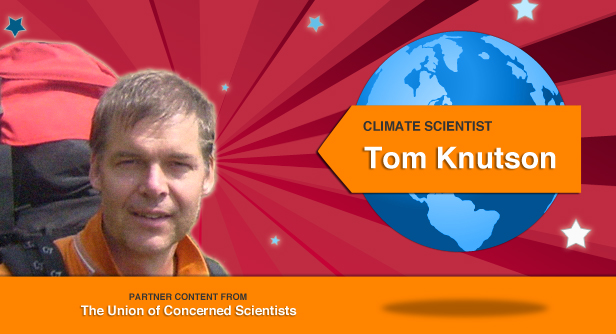The 2010 hurricane season is winding down, but teams of meteorologists are still working around the clock to track tropical storms as they continue to form in the Atlantic Ocean. Thomas Knutson tracks hurricanes too, but a little differently.

A meteorologist at the National Oceanic and Atmospheric Administration (NOAA), Knutson is trying to answer one of global warming’s thorniest and most consequential questions: What effect will rising global temperatures have on the frequency, structure, and intensity of future storms?
Five years after Hurricane Katrina devastated the Gulf Coast — causing more than 1,800 deaths and close to $100 billion in damage — there is little doubt about the urgency of Knutson’s research.
Knutson remembers the scene when he first visited Gulfport, Miss., a few years ago; 30-foot-high water marks testified to Katrina’s devastating surge. “Storms like Katrina are thankfully rare,” he says. “But when you see how hard they hit, it reminds you how bad things can be and how vital it is to prepare and plan ahead.”
The extreme danger posed by hurricanes like Katrina motivates Knutson and his team at NOAA’s Geophysical Fluid Dynamics Laboratory, which is located on the campus of New Jersey’s Princeton University.
Growing up in a tiny town in rural Virginia, the teenage Knutson first encountered climate change when he read an article about the phenomenon in the Washington Post. “It captured my imagination,” he recalls. Knutson was influenced too by his father’s work as a geologist at a local zinc mine. “I was steeped,” says Knutson, “in a certain ‘geological’ way of looking at the world.”
Knutson earned an undergraduate degree in computer science, then went on to graduate studies in meteorology at the University of Wisconsin-Madison. For the past two decades, he has been a research scientist at NOAA. But Knutson is quick to acknowledge that teasing apart the relationship between global warming and hurricanes is an exceedingly complex business.
First, says Knutson, there is the data problem. “Reliable satellite data for hurricane intensities exists only as far back as about 1980,” he says. Before that, scientists like Knutson and his colleagues must rely on what he calls “a hodgepodge” of information.
“We know a lot about hurricanes that made landfall for the past century or more,” he explains. “But if a hurricane didn’t hit land, it’s a different story, and, of course, many don’t hit land.” Before the mid-1940s, the only information about those tropical storms and hurricanes that never struck land came from ships that happened to be in the vicinity and recorded wind strengths in their logs. In recent decades there have been just 11 named tropical storms each year in the Atlantic. On average, only a few (2.3 on average) have developed into hurricanes of category three or higher. The relative rarity of these large hurricanes — what Knutson calls “the small size of the signal” — makes statistical analysis even trickier.
Today, the evidence is overwhelming that carbon dioxide and other heat-trapping gases are warming summer sea-surface temperatures to levels that allow hurricanes to develop. But “to predict how hurricane activity may change,” says Knutson, “we need to know a lot of fine-grained detail about things like the local pattern of sea-surface temperature, not just the global average.” Current climate change models use grids that are 62 to 124 miles in size, roughly the distance between New York City and Philadelphia. That scale, says Knutson, is “roughly two orders of magnitude too crude for the purpose of simulating hurricane intensities.”
To overcome the limitations of data and scale, Knutson and his team have developed an ingenious strategy. “Rather than wait a few decades until climate models offer enough resolution to predict storm formation,” says Knutson, his team “telescopes in.” They borrow data about future climatic conditions from 18 separate world climate models and plug it into the more detailed regional weather forecasting models that NOAA uses to track current storms.
Using supercomputers, Knutson’s team tested the approach by entering atmospheric and sea-surface temperatures measured in recent years, including the 2005 hurricane season that produced Hurricane Katrina. Only after determining that their detailed regional model could offer a realistic picture of intense hurricane activity in those years did they run the model with anticipated future conditions.
Knutson’s results so far show both good news and bad. On the positive side, global warming is likely to mean less frequent hurricanes in the Atlantic, largely because higher wind speeds in the upper atmosphere will disrupt many of them. But models indicate that storms which do materialize will likely grow to be more intense. Knutson’s latest modeling study projects that the number of category four and category five hurricanes in the Atlantic will double by the end of this century, making a catastrophic storm like Katrina considerably more likely.
Knutson also warns that today’s climate models uniformly project that the hotter atmosphere brought about by global warming will retain more moisture. For developing hurricanes, this means more intense precipitation — some 20 percent higher rainfall rates, according to Knutson’s calculations. In addition, he says, current estimates of rising sea levels over the coming century mean that the storm surges caused by intense hurricanes are likely to be more devastating than ever before.
Knutson and his team are already refining their hurricane research. Ultimately, global climate models should become fine-grained enough to predict the formation of storms. Meanwhile, coastal communities are paying close attention to Knutson’s findings so they can brace for these rare but intense hurricanes and make better plans to cope with them.
“We live in a unique time,” Knutson says. “Unfortunately, we have been running a global experiment that is perturbing the climate system in profound ways, and climate affects many things in our natural world. I’m glad to work on a project that can at least help us predict and anticipate some of these effects so we can make more informed decisions.”
This is the 13th installment of America’s Climate Scientists: A series from the Union of Concerned Scientists. Click here to read all the climate scientist profiles.
The Union of Concerned Scientists is currently leading a campaign to elevate the voices of climate scientists and educate the public about the overwhelming scientific evidence for human-caused global warming. Learn how you can get involved at www.ucsusa.org/evidence.




